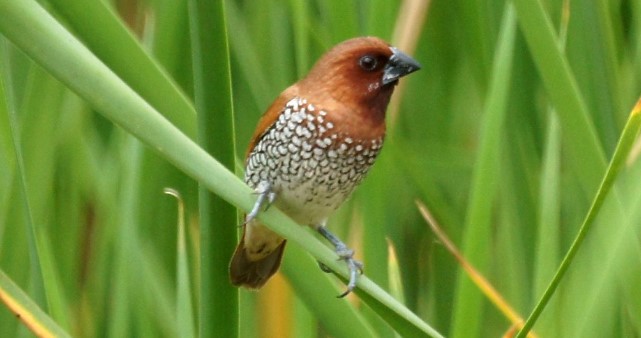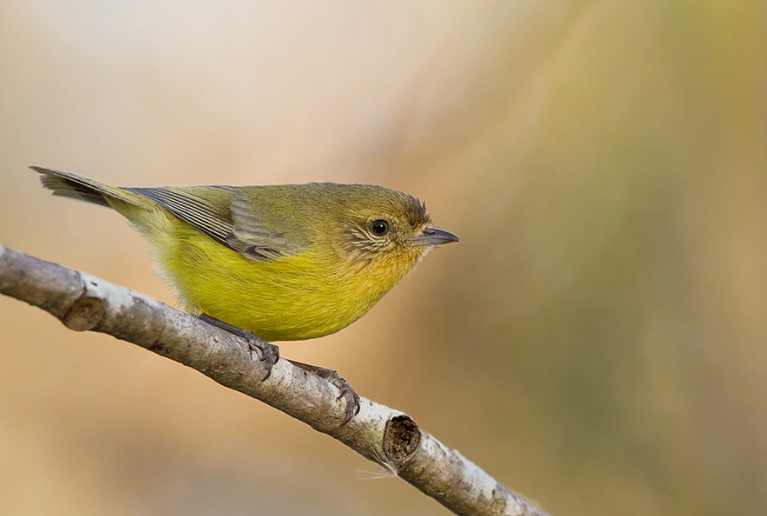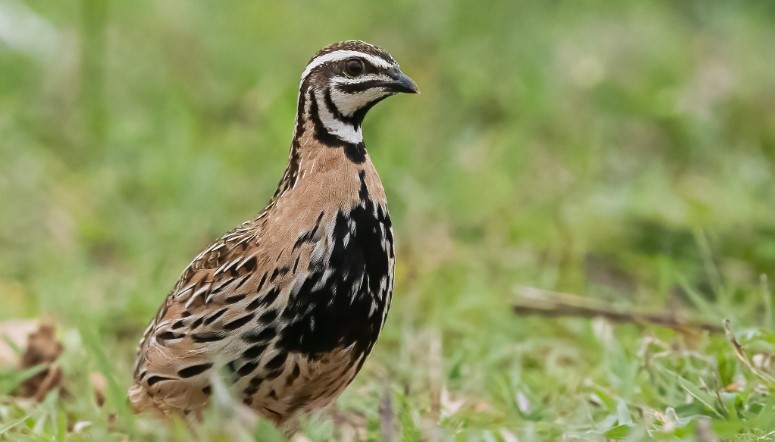The Nutmeg Mannikin (Lonchura punctulata) is a bird commonly seen along the east coast of Australia today. Among its favorite habitats are long grasses and rank plant life along roads and riverbanks, as well as cane fields and crops near farms. It is not uncommon for several dozen birds to pass in tight formation before suddenly turning and disappearing into the long grass. The behavior of mannikins is characterized by this.
Carl Linnaeus described and named it in 1758 as a species of the genus Lonchura. Throughout the body, it has distinct feather markings resembling scales. Native to southeastern Asia, the Nutmeg Mannikin was first introduced to Australia in Brisbane in the late 1930s, then in Sydney in the 1940s, and finally in Townsville and Rockhampton in 1950 and 1954.
Aviary birds have been released most often if not all. During the 1960s, they established themselves around Cairns and Mackay and through most of the country in between, and by 1961 they had reached Cooktown. Their breeding is restricted to cooler winters in the south, where they have moved more slowly.
Despite the fact that it took them 20 years to reach Grafton from Brisbane, they are still confined to the area around Sydney. A rural habitat is colonized rather than an urban one. Even after removing a competitor from the cryptic seeds foraging environment, individuals with low efficiency continued to forage with cryptic seeds. Foragers who forage socially may incur a higher cost of foraging on cryptic prey than those who forage alone.

In parts of the world north of the Tropic of Capricorn, nesting is almost year-round, as they can eat seeds of almost any grass or herb. Consequently, they can represent an overwhelming threat in tropical grasslands to native finches. Their nimble feet help them climb between grass- and herbheads nimbly in pasture to gather grain. Rather than eating insects, young birds eat mostly half-ripe seeds; they scavenge for scraps around farms and garbage dumps, and some populations pick at road-killed animals’ flesh.
The Nutmeg Mannikins are extremely social creatures, always forming close-knit groups to feed, fly, and sleep together. Calling incessantly, perching together to groom one another, and ‘jingling’ and peering, they are not afraid to get in contact with one another. In addition to flicking their tails and wings constantly, they also flap their wings. A male does not only sing in courtship, he also ‘jingles’ at any time, individually or in a duet or trio.
Peering at a solitary bird, both sexes, young and old stare at it in wonder. The bond between the members of a group appears to be strengthened. Many birds cluster together at night to sleep in special nests in bushes and trees, as many as 15-20 at a time. As they zigzag around each other between small branches, both partners pick up and drop small pieces of grass. Once he has landed near the female, the male drops a grass stem, wipes his bill a number of times, and assumes a singing posture. When he bobs up and down and pivots his whole body from side to side, he ruffles the feathers on his head and belly and lowers his tail.
As he does so, he keeps his level bill partly closed; only opening it wide at the end of the phrase does he pour out the louder notes. The male alternates between this upright posture and bends and twists of the body toward the female. In the end, she quivers her tail to invite him to mount. It is common for Nutmeg Mannikins to nest in dense colonies in trees and shrubs surrounding their feeding grounds during the breeding season, rearing successive broods in succession.
The nests sometimes touch each other, but they are usually about three meters apart and well camouflaged. Breeding, incubation, feeding, and nest building are all shared by both sexes, passing on food via regurgitation. About three weeks after hatching, the young fledge. The majority of social foragers must search for food while also avoiding predators. The position of the head of individuals who play scrounger is also associated with alertness to predators and thus contributes to antipredatory vigilance.
The Nutmeg Finch is also known as the Spotted Munia, Nutmeg Munia, Spice Mannikin, and Scaly-breasted Munia. Approximately 110-120 mm is the length of Nutmeg Mannikin. There is a similarity between the sexes. There is a faint pale shafting on the back, wings, and rump of the bird. The back, wings, and rump are brown. The tail and upper tail covers are grey-yellow. The throat is dusky chestnut in color. There is a heavy scalloping of dark brown on the rest of the underparts. There is a brown-red color to the eyes. Blue-grey is the color of the bill and feet. There is no scalloping on the underside of the immature bird. It is pale brown above; dull yellow-brown below.
Nutmeg Mannikin’s calls are soft chip in contact, loud, variable kit-leeee in identification, and sharp tret-tret in alarm. Nutmeg Mannikin’s song, however, is almost inaudible, consisting of very soft descending notes followed by high flute-like whistles and bill rattles, followed by a long descending whistle.
In northeastern Queensland, nesting and breeding occur throughout the year; in southern Queensland, it occurs during spring and summer. The nest consists of a large chamber and a short side entrance tunnel of green grass and leaves, measuring 170-220 mm in length, 180-200 mm in height, and 130-150 mm in width, all within the foliage of shrubs and trees. There are four to seven oval, 17 x 12 mm, pure white eggs laid by this bird. There is a 12- to 13-day incubation period for both sexes. Twenty to twenty-two days after hatching, the young fledge.
As far as distribution is concerned, it has been introduced and established between Cooktown, Qld, and Sydney; inland on Darling Downs. From India and Sri Lanka east to Indonesia and the Philippines (where it is known as mayang paking), this species is endemic to Asia. The species has spread to several other parts of the world, including Puerto Rico and Hispaniola, Australia, and parts of the United States, with sightings occurring in California.
Its natural range extends from Pakistan to Sulawesi and the Lesser Sundas. Only one race is found in Australia out of twelve. There are no threats to this species globally, and it is found throughout most of its range in abundance. Some bird populations are dwindling, however, due to bird cages.







